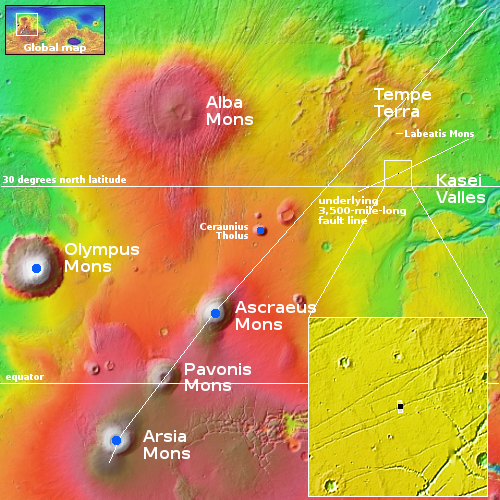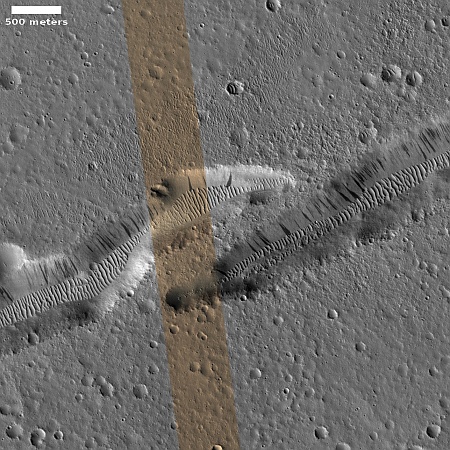A crack on Mars more than 600 miles long
Cool image time! The picture to the right, cropped and reduced to post here, was taken on March 29, 2024 by the high resolution camera on Mars Reconnaissance Orbiter (MRO).
The science team labels this “troughs in Labeatis Fossae.” On Mars, the word “fossae” is used to indicate regions where there are a lot of parallel fissures. Though there are a few examples where such fissures might have been caused by the movement of ice or water, carving out the channel, in almost all cases this is not the cause. Instead, fossae are usually formed when the surface stretches, either because underground upward pressure pulls it apart, or because there is a sideways spread at the surface. The resulting cracks are generally considered what geologists call “grabens,” depressions caused at faultlines when the ground on either side moves apart in some manner.
In this case the break in the trough proves this is a graben, though why it broke at this spot is not clear.

The black dot on the overview map to the right marks the location, almost in the center of this approximately 600-mile-long fissure, which is one of many similar long fissures that form Labeatis Fossae and are found to the south of the low-lying shield volcano Labeatis Mons.
While at first glance one might think these cracks were due to that volcano, the larger picture says no. Instead, it appears both the cracks and the volcano were produced by a much larger geological event, related to the 3,500-mile-long crack that aligns with three of Mars’ biggest volcanoes, and also produced numerous other parallel cracks in this region.
Though the actual cause remains unknown, there is the possibility that the cracks and volcanoes on this side of Mars exist because of the impact that created Hellas Basin on the other side of Mars. This hypothesis is pure speculation on my part, but I am quite sure it has occurred to a number of planetary scientists. To prove it however it will be necessary to date in great detail samples from both locations, something that is not going to happen until human geologists are walking the planet.
A minor side detail: The blue dots at the top of four of the volcanoes are where scientists analyzing orbital data have detected frost.
On Christmas Eve 1968 three Americans became the first humans to visit another world. What they did to celebrate was unexpected and profound, and will be remembered throughout all human history. Genesis: the Story of Apollo 8, Robert Zimmerman's classic history of humanity's first journey to another world, tells that story, and it is now available as both an ebook and an audiobook, both with a foreword by Valerie Anders and a new introduction by Robert Zimmerman.
The print edition can be purchased at Amazon or from any other book seller. If you want an autographed copy the price is $60 for the hardback and $45 for the paperback, plus $8 shipping for each. Go here for purchasing details. The ebook is available everywhere for $5.99 (before discount) at amazon, or direct from my ebook publisher, ebookit. If you buy it from ebookit you don't support the big tech companies and the author gets a bigger cut much sooner.
The audiobook is also available at all these vendors, and is also free with a 30-day trial membership to Audible.
"Not simply about one mission, [Genesis] is also the history of America's quest for the moon... Zimmerman has done a masterful job of tying disparate events together into a solid account of one of America's greatest human triumphs."--San Antonio Express-News
Cool image time! The picture to the right, cropped and reduced to post here, was taken on March 29, 2024 by the high resolution camera on Mars Reconnaissance Orbiter (MRO).
The science team labels this “troughs in Labeatis Fossae.” On Mars, the word “fossae” is used to indicate regions where there are a lot of parallel fissures. Though there are a few examples where such fissures might have been caused by the movement of ice or water, carving out the channel, in almost all cases this is not the cause. Instead, fossae are usually formed when the surface stretches, either because underground upward pressure pulls it apart, or because there is a sideways spread at the surface. The resulting cracks are generally considered what geologists call “grabens,” depressions caused at faultlines when the ground on either side moves apart in some manner.
In this case the break in the trough proves this is a graben, though why it broke at this spot is not clear.

The black dot on the overview map to the right marks the location, almost in the center of this approximately 600-mile-long fissure, which is one of many similar long fissures that form Labeatis Fossae and are found to the south of the low-lying shield volcano Labeatis Mons.
While at first glance one might think these cracks were due to that volcano, the larger picture says no. Instead, it appears both the cracks and the volcano were produced by a much larger geological event, related to the 3,500-mile-long crack that aligns with three of Mars’ biggest volcanoes, and also produced numerous other parallel cracks in this region.
Though the actual cause remains unknown, there is the possibility that the cracks and volcanoes on this side of Mars exist because of the impact that created Hellas Basin on the other side of Mars. This hypothesis is pure speculation on my part, but I am quite sure it has occurred to a number of planetary scientists. To prove it however it will be necessary to date in great detail samples from both locations, something that is not going to happen until human geologists are walking the planet.
A minor side detail: The blue dots at the top of four of the volcanoes are where scientists analyzing orbital data have detected frost.
On Christmas Eve 1968 three Americans became the first humans to visit another world. What they did to celebrate was unexpected and profound, and will be remembered throughout all human history. Genesis: the Story of Apollo 8, Robert Zimmerman's classic history of humanity's first journey to another world, tells that story, and it is now available as both an ebook and an audiobook, both with a foreword by Valerie Anders and a new introduction by Robert Zimmerman.
The print edition can be purchased at Amazon or from any other book seller. If you want an autographed copy the price is $60 for the hardback and $45 for the paperback, plus $8 shipping for each. Go here for purchasing details. The ebook is available everywhere for $5.99 (before discount) at amazon, or direct from my ebook publisher, ebookit. If you buy it from ebookit you don't support the big tech companies and the author gets a bigger cut much sooner.
The audiobook is also available at all these vendors, and is also free with a 30-day trial membership to Audible.
"Not simply about one mission, [Genesis] is also the history of America's quest for the moon... Zimmerman has done a masterful job of tying disparate events together into a solid account of one of America's greatest human triumphs."--San Antonio Express-News


